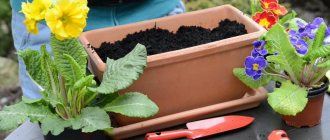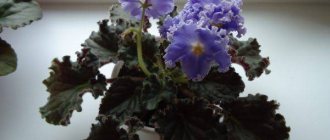Planting and caring for perennial primrose does not require special knowledge and skills. This charming spring flower is considered an unpretentious plant that even an inexperienced gardener can grow. Primrose has hundreds of varieties and often becomes the main decoration of a balcony or terrace. It is used to create beautiful compositions in the garden landscape.
Primrose is not demanding in care and does not create unnecessary trouble for gardeners
Features of growing perennial garden primrose from seeds
Perennial primrose grows and develops well in open ground, blooms profusely, and is grown from seeds. Although this method of reproduction is labor-intensive and time-consuming. Planting material of some perennial varieties requires mandatory stratification. Sowing is demanding in the choice of seeds, which, even under optimal storage conditions, can quickly lose their viability. Regardless of the type of plant, it is important to pay attention to their expiration date. Experienced gardeners claim that the more expensive and newer the variety, the higher the risk of non-germination. When purchasing perennial primrose seeds, you should look at the collection date. If they are more than a year old, then it is likely that the seedlings will not be friendly. Therefore, it is better to collect them yourself, if possible.
Comment! The older the planting material, the longer its germination will take.
The best time for planting primroses is considered to be from February to March. But experienced gardeners often begin sowing seeds as early as January. Such early planting allows you to get a flowering plant in the spring. And if primrose is sowed in April or May, then flowers will appear on it next year.
Reproduction
When planting primroses in your home plot, you need to pay attention to the distribution area of the variety. Here we can distinguish 2 large groups: those that grow on swampy soils, and those that grow on rocks. The first need humus-rich, moist areas, and the second need dry areas. Reproduction of flowering plants is possible in several ways. All of them can reproduce by seeds, and in the natural environment this is the only method of reproduction.
At home conditions are also available:
- dividing the bush;
- planting seedlings;
- cuttings
You need to divide old bushes that are over 3 years old. They are easy to notice by the fact that the rosette may have several growing points and many small leaves. Seedlings are grown in early spring from seeds harvested in summer. Cutting is planting a primrose leaf in the soil for rooting. Once this happens, the plant will create a new growing point and the first leaves will appear from it next to the leaf you planted. Expect the first flowering in the second year after planting. Primroses are hardy and should survive the winter well.
Dividing the bush
The division of the bush is carried out in August or early autumn - after the plants have flowered and the active growing season has ended. Such an event should be held every 3-4 years.
Types and varieties of perennial primrose
The variety of primroses is enormous. Their genus includes 400 species, excluding hybrids and varieties that were developed during the work of breeders. Its lifespan, color scheme, size and shape depend on the type and variety of the plant. There are those that can withstand winter and can withstand frosts down to -40 degrees.
Ordinary
The common primrose (Primula vulgaris) is a popular species among gardeners. It is characterized by the absence of stems, multi-colored colors, and compact sizes (up to 10 cm in height). The perennial blooms from February to March. Grows in pots and flower beds. Famous varieties: “Jacpot”, “Harlequin Bicolor”, “Cobalt Blue”, “Amethyst Ice”.
Common primrose can be grown on a terrace or balcony at temperatures above -5 degrees
Ushkovaya
Primula auricula - found in meadows and calcareous rocks. The leaves of the species are collected in a mundane rosette, located on short petioles. The flowers are bell-shaped, have a pleasant aroma, and appear in April or May. Famous varieties: “Pegasus”, “Auricula”.
The auricular inflorescences smell like apricot
Julia
A variety of perennial primrose Julia (Primula Juliae) prefers to grow near bodies of water. The flowers are single, lilac in color with a yellow spot in the center. The flowering period is from April to June. Suitable varieties for the garden are: “Sylvia”, “Green Lady”.
When growing Julia, you should not overuse nitrogen fertilizers.
Large-flowered
Perennial large-flowered primrose (Primula grandiflorus) is a very popular species among summer residents. Its flowers are voluminous and come in different shades: green, purple and yellow. The most popular variety is “Francesca” with light green flowers, as well as “Selecta”, “Coco”, “Gator Stiletto”.
The flowers of the large-flowered variety are much larger than those of other species
Terry
Perennial double primrose (Terricus) - has flowers of a different palette. The plant is low and frost-resistant. The best varieties of the species are considered to be “Rosella”, “Frost”, “Rosie”.
Terry primrose tolerates Russian winters well
Mealy
Perennial powdery primrose (Primula farinosa) can grow up to 30 cm in height. Blooms with purple-pink buds from May to September. The leaves are mossy underneath and have a characteristic central vein on the surface.
Powdery primrose can be found in Eurasia and South America
Siebold
Siebold's primrose (Primula sieboldii) has elongated leaves and an elongated peduncle up to 30 cm long. It blooms for two months with buds of various flowers. Interesting varieties: Manakura, Carefree.
Sometimes Siebold is painted in two colors with stripes or eyes on the petals
High
High primrose (Primula elatior) grows up to 0.4 m. The buds are two-colored, located on hanging stems, have an orange neck and a yellow border. Based on the species, many hybrids and varieties have been bred: “Max”, “Louis”, “Suzannah”.
In the wild, tall perennial primrose is found in the Urals, the Alps and the Pyrenees
Japanese
Japanese primrose (Primula japonica) has large long leaves (25 cm) and long flowering. The inflorescences of the plant are arranged on stems in several tiers and are colored crimson. Common varieties are Apple Bloss and Alba.
Japanese primrose blooms for about 40 days
Obkonika
The perennial primrose Obconica (Primula obconica) can grow up to 30 cm. It blooms with red, white, pink buds with a green eye. It has beautiful leaves on long petioles.
Obconia reproduces well by seeds
Polyanthus
Perennial polyantha primrose (Primula polyantha) lives on average 2 years. The flowering period lasts from May to June. This species comes in a variety of colors. The buds are purple, orange, yellow and red.
Polyanthus primrose has good winter hardiness and blooms for a long time.
Selection and preparation of containers
With the choice of landing container, everything is now very convenient and simple. In any store specializing in goods for the garden and garden, or a regular hypermarket, you can buy a variety of containers for planting. You can also use improvised means, for example, various bowls, cut plastic bottles, etc.
It is very convenient to plant primrose seeds in the following containers:
- plastic box:
- wooden box;
- plastic cassettes;
- peat pots;
- plastic cups;
- peat tablets.
Since flower seedlings need picking, it is very convenient to initially sow the seeds in a common plastic or wooden box, and then plant them . But when growing in peat tablets, there is no need to pick seedlings.
Important! There must be drainage holes at the bottom of the planting container. If you did not find them when purchasing, then you need to make holes yourself. The exception is peat tablets and pots; there is no need to make holes in them!
Before planting seeds, it is recommended to disinfect containers (except peat tablets). Simply rinse the container with a solution of potassium permanganate or a fungicide solution.
How to grow perennial primrose from seeds
In addition to propagation by division, perennial primrose can be grown from seeds, although the method is considered more complex and labor-intensive. Seeds are grown both for seedlings and in open ground. In the first case, sowing is carried out starting at the end of January, in the second - before winter.
For planting, use universal soil. Pour it into containers, water it, distribute the planting material on top and gently press it in, moisten it with a spray bottle with water with the addition of a fungicide. Cover the container with a transparent lid and send it to a room with a temperature of +12 to +18 degrees.
After the seedlings emerge, shade from the sun is provided and regular watering is provided. The soil should be moist, but not waterlogged. Also, from the moment the seedlings appear, you should not forget to constantly ventilate the containers; after a pair of true leaves have grown, the lids can be removed from them.
During cultivation, seedlings of perennial primroses need 2-3 pickings. They are planted in open ground when the threat of frost has passed.
Important! Seeds of certain species of perennials require stratification. Before sowing, this point should be clarified.
The plant from seeds blooms the next year
When to sow seeds in open ground
The best time for sowing perennial primrose seeds in open ground is the end of summer, the period after they ripen. With proper care, this planting provides maximum germination.
Sowing plant seeds in the fall, from September to November, is also considered effective. In this case, the young shoots will begin active growth in the spring and, possibly, will bloom in the same year. Some gardeners plant perennial primrose seeds in open ground in the spring, but this method gives the worst results. Sowing is carried out immediately after the snow melts. It is better to do this in a pot dug into the ground. Then they constantly make sure that the surface of the soil in it is not washed away by rain or does not dry out.
Advice! The method of planting seeds in open ground is more suitable for species with large seeds.
How to sow seeds correctly
The perennial shows the best seedlings when planting fresh seeds. This is an important condition when growing crops. Stale planting material germinates slowly and may not produce seedlings at all.
Primrose seeds are small, so there is no need to plant them in the ground. The planting procedure begins by filling the box with soil, after which the material is evenly scattered over it and then moistened with water. If there are few seeds, they can be spread on the surface of the soil with a toothpick dipped in water.
The seeds of the plant are very small, 1 gram contains about 450 pieces
Sowing seeds for seedlings
Seeds for future seedlings are sown at the very beginning of February. For the procedure, small special boxes installed on open ground are used. The container is filled with turf-leaf soil and sand in a ratio of 2:1:1. The seed material is distributed over the surface of the mixture, with some indentation. For 1 sq. cm there should be no more than 5 seeds.
After planting, the box is placed in a plastic bag and placed in the freezer of the refrigerator. The freezing time at a temperature not exceeding -10 °C is 3-4 weeks. Then the boxes are installed in the same form on the windowsill. The soil mixture should be slightly moistened, and the temperature should not exceed 17 degrees Celsius.
While waiting for shoots, the summer resident will have to be patient - they will not appear soon. But after the first sprouts emerge from the ground, the bags open slightly, allowing access to air. After a couple of weeks, the cover can be removed completely.
Caring for perennial primrose in open ground
Planting and caring for perennial primrose in open ground is not difficult. After the plant has taken root in a permanent place, it is cared for according to the following algorithm:
- Provide moderate watering at least once a week.
- Do not allow a dry crust to form on the ground; loosen the soil regularly.
- Remove weeds and wilted flowers in a timely manner.
- Feed the crop at least twice a month.
- They are transplanted to another place every 4 years, while dividing the bushes.
- Cover plants for the winter with bark, peat, pine branches or dry leaves.
Attention! In order for a perennial primrose to bloom annually, it must be fertilized frequently, and alternate phosphorus and potassium fertilizers.
Wintering the plant
For the most part, primroses are frost-resistant. They don’t freeze out so much from frost as they get damp from large amounts of moisture – melt water and rain. Therefore, it is not recommended to plant them in lowlands and clay soils that retain water.
Do not cover the bushes with plastic buckets under any circumstances; in this case, the plants will completely dry out. Very few varieties require good shelter; most generally overwinter without special preparation, or they are lightly covered with fallen leaves or spruce branches.
Diseases and pests
Sometimes a perennial primrose can get sick or be attacked by harmful insects. Common plant infections include:
- rot of the stem and root collar;
- cucumber mosaic;
- powdery mildew;
- bacterial spot;
- gray mold;
- jaundice;
- rust.
Ramularia cercosporella, a fungus that appears in late spring in the form of brown spots on the leaves, causes enormous harm to perennial primroses. If a disease is detected, the plants should be immediately sprayed with an antifungal drug and the affected leaves should be removed.
As for pests, perennial primrose can become a victim of insects such as:
- aphid;
- fleas;
- spider mite;
- weevil;
- slugs
Attention! Experienced gardeners recommend regularly inspecting the crop for infections and parasites.
In order to prevent illnesses, it is necessary to treat the bushes with Fundazol, Topsin or Bordeaux mixture every spring. In the fall, it is advisable to spray the plants with the insecticide Nitrofen.
The culture is not highly immune to diseases and pests
Top dressing
An adult crop begins to bloom almost after the snow melts. Therefore, for its restoration and future lush flowering, it is recommended to fertilize. Any nitrogen mineral supplement can serve it. It is advisable to lay it while loosening the earth.
After two weeks, you can add phosphorus fertilizer, which has a beneficial effect on the duration of flowering of the springs. It is possible to water the plant with liquidly diluted cow manure, at the rate of a liter of product per bucket of water.
A good addition to enrich the soil is humus, leaf soil or compost. It is not recommended to use fresh peat as an additive.
It is undesirable to overuse nitrogenous fertilizers, which activates the growth of green mass, but not the development of flower stalks.
Common mistakes and recommendations
If you improperly care for perennial primrose, various problems can arise. Some of the mistakes gardeners make include:
- Drying and withering of leaves. Occurs due to lack of moisture and exposure to direct sunlight.
- Poor flowering. Occurs due to nutritional deficiency.
- Root rotting. May occur as a result of watering with cold water.
Among the tips for planting and caring for perennial primrose, the most common are the following:
- It is important to choose the right place for the plant. The location should be in partial shade. It is advisable that the flower bed be well lit in the spring and hidden from direct sunlight in the summer, for example, under deciduous trees.
- The soil should be fertile, loamy, with humus. For the Japanese and mealy species, a peat substrate is required.
- The soil should be constantly moistened; perennial primrose is poorly resistant to drought.
- The crop requires feeding regularly.
Let's summarize
- Street (garden, yard) primroses are replanted every three to four years. The plant must be at least 4 years old.
- Transplant time is mid-spring or early autumn.
- When transplanting, overgrown bushes are divided. The transplanting procedure rejuvenates them, promoting better flowering.
- The roots of bushes taken out of the ground are shaken off, washed in water, and then divided into 2-4 parts with a sharp knife so that on each division there remains a renewal point from which a leaf rosette grows.
- Cuts on the bushes are powdered with ash or crushed coal. The bushes are planted in a flowerbed and watered.
You will learn more about the different types of primroses, as well as about caring for these wonderful flowers, from this video:
Perennial primrose in landscape design
Perennial primrose looks great in almost any corner of the garden and can be combined with other flowers and ornamental shrubs. It is used as a decoration for alpine slides, borders, lawns, ponds, framing alleys and benches. Toothed, auricular and polyantha primroses are best suited for this. The plant is often planted under bushes and trees, along garden paths. The culture feels good in pots, flowerpots and cache-pots, and serves as decor for balconies, gazebos and stairs. Flower beds look beautiful where different species and varieties of perennial primrose grow, with different flowering periods. With this combination, you can admire the bright buds from early spring until the end of summer.
The perennial is considered a good neighbor and does not displace anyone. Primrose's companions are herbs and flowers, which, like her, prefer moderate humidity and diffuse shade. The plant develops well in tandem with astilbe, hosta, fern and dwarf conifers. Many people plant primrose with crocuses, hyacinths, pansies, and complement the composition with evergreens, such as ivy and boxwood. The culture looks good when planted in a diamond pattern, in rows, in a semicircle and around garden statues. In small areas, primrose is planted as a tapeworm on the lawn.
Perennial primrose is an excellent companion that does not interfere with the growth and development of its neighbor
Why is this flower interesting?
Garden primrose has many varieties and is characterized by early, abundant flowering. Plants bloom in early spring among the first on the site. They are unpretentious in care and take root in regions with any climate, which is why they are popular among gardeners. These beautiful flowering plants are also often used in landscape design.
Common types
According to scientists, there are more than 500 varieties of primrose in the world. Since this plant is quite common in the wild, it can be assumed that there are many more of them and the real number exceeds the number we know by several times.
Officially, a little more than 30 species of primrose can be found in Europe. Moreover, more than 300 species grow in Asia, mainly in China. Several species can be found in Africa and Latin America. One species of primrose has even been recorded on the island of Java.
The most popular varieties can be considered:
- Primrose stemless. In this species, the inflorescences cover the short stem so tightly that it becomes completely invisible. The dome of inflorescences forms a beautiful yellow-pink cap.
- Alpine primrose. It has a dense tall stem, which is crowned by a ball of densely planted yellow inflorescences. May resemble a miniature version of a daffodil. This species grows mainly in the north and loves direct sunlight.
- Giga White. It is a very small white inflorescence that forms a ball shape and grows on a thick stem.
- Cerulea. They have a small thin stem that is decorated with an umbrella-shaped purple flower with thin white veins and a bright yellow core.
- Polyantha primrose. The low stem is decorated with several medium-sized red-yellow flowers.
Useful properties of primrose
It is known that manganese salts are present in significant concentrations in all parts of the plant. In addition, the above-ground parts of the crop are rich in vitamins (ascorbic acid, carotene and others), and the rhizome is rich in essential oils and glycosides.
These qualities made it possible to use primrose both in cooking and in folk medicine.
Infusions and decoctions, medicinal teas and primrose infusions are used to treat:
- vitamin deficiency;
- respiratory tract diseases;
- rheumatic pain;
- kidney and urinary tract diseases (diuretic);
- colds and sore throats;
- headaches;
- neuroses and sleep disorders;
- reducing external hemorrhages.
The only contraindication for the use of primrose-based formulations is its individual intolerance.
However, you should know that the hairs on primrose leaves contain chemical compounds that cause allergic skin rashes in many people.











